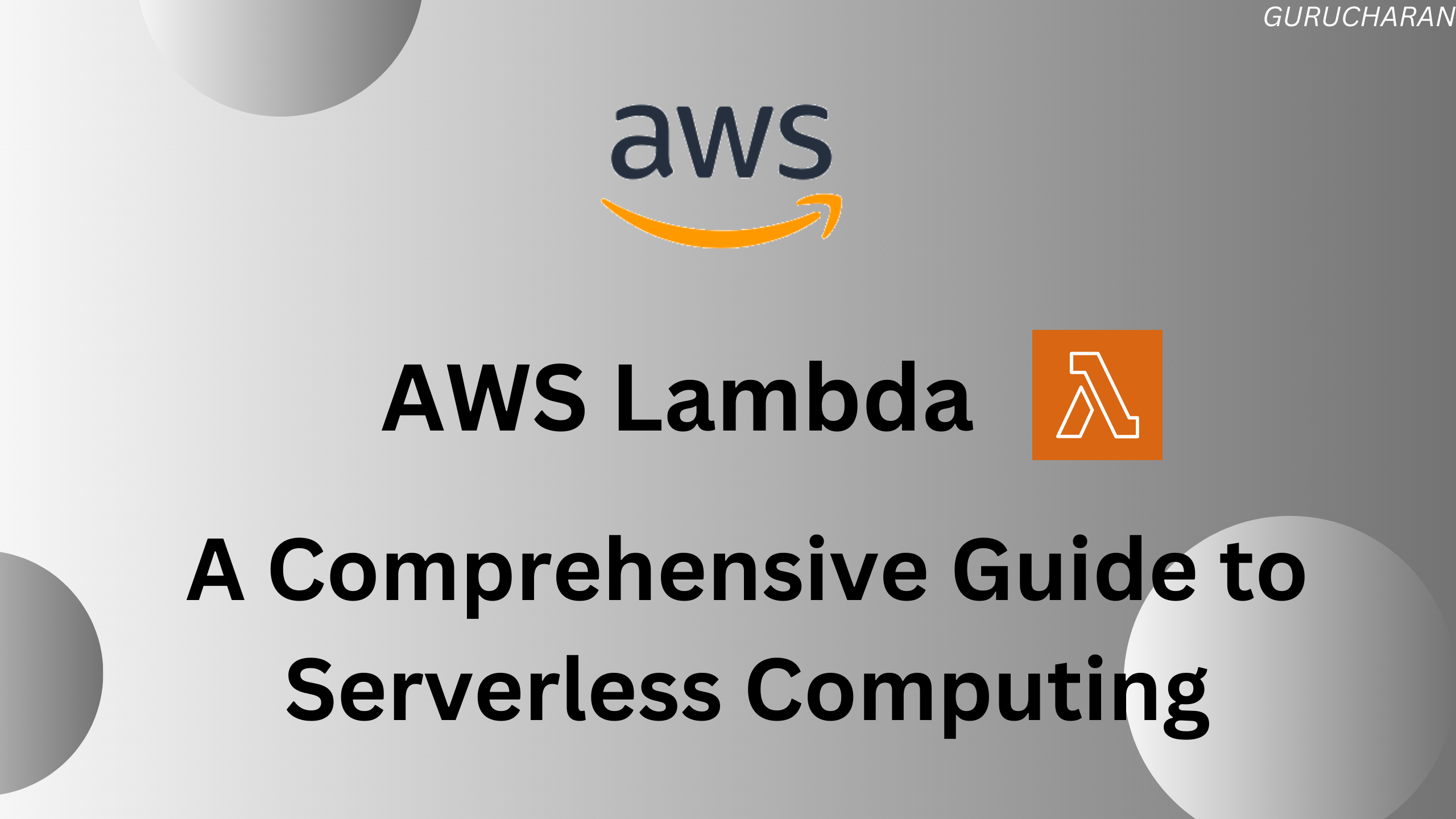AWS Lambda A Comprehensive Guide to Serverless Computing
 Gurucharan
Gurucharan
Introduction
In today's era of cloud computing, serverless architecture has revolutionized the way applications are built and deployed. AWS Lambda, a serverless computing service provided by Amazon Web Services (AWS), has emerged as a popular choice among developers and organizations seeking a scalable and cost-effective solution. In this blog, we will explore AWS Lambda in detail, discussing its key features, benefits, use cases, and how it works.
What is AWS Lambda?
AWS Lambda is a serverless computing service offered by AWS. It enables developers to run code without provisioning or managing servers. With AWS Lambda, developers can focus solely on writing the application code, while AWS handles all the underlying infrastructure and scaling requirements. Lambda executes code in response to events and automatically scales resources to match the incoming workload.
How Does AWS Lambda Work?
AWS Lambda follows an event-driven architecture. Developers define Lambda functions, which are small units of code, and associate them with specific events or triggers within the AWS ecosystem. These events can include changes in data on an S3 bucket, updates to a DynamoDB table, incoming messages on an Amazon Simple Notification Service (SNS) topic, or even custom HTTP requests through API Gateway.
When an event occurs, AWS Lambda automatically provisions the necessary compute resources to run the associated code. The code executes within a secure and isolated environment, and developers have the flexibility to choose their preferred programming language, including Node.js, Python, Java, C#, Ruby, and Go.
Key Features of AWS Lambda
Scalability: AWS Lambda automatically scales resources based on the incoming workload, ensuring that applications can handle any level of traffic without manual intervention.
Event-driven: Lambda functions are triggered by events within the AWS ecosystem, allowing developers to build highly responsive and reactive applications.
Pay-per-use pricing: With AWS Lambda, you only pay for the actual compute time consumed by your functions. There are no upfront costs or charges for idle resources.
Integration with other AWS services: Lambda integrates seamlessly with various AWS services, including Amazon S3, DynamoDB, SNS, API Gateway, and more, allowing developers to build sophisticated serverless architectures.
Built-in fault tolerance: AWS Lambda automatically monitors and replaces failed compute instances, ensuring high availability and fault tolerance for your applications.
Easy deployment and versioning: Developers can easily deploy and manage different versions of Lambda functions, allowing for seamless updates and rollbacks.
Benefits of Using AWS Lambda
Reduced operational overhead: By offloading server management and infrastructure provisioning to AWS, developers can focus more on writing code and delivering value to their applications.
Increased scalability: AWS Lambda scales seamlessly based on demand, eliminating the need to provision and manage servers manually.
Cost-effective: With pay-per-use pricing, you only pay for the actual compute time consumed by your functions, making it cost-effective, especially for sporadic workloads.
Faster time to market: By leveraging AWS Lambda, developers can rapidly develop and deploy applications, significantly reducing the time to market for new features and services.
High availability and fault tolerance: AWS Lambda automatically manages compute instances and handles failures, ensuring that your applications are highly available and resilient.
Use Cases for AWS Lambda
Real-time file processing: Lambda functions can be triggered when new files are uploaded to an S3 bucket, allowing you to process the data in real-time, such as extracting information, transforming data, or triggering downstream processes.
Data transformations and ETL: Lambda functions can be used to transform and process data in real-time as it flows through different stages of an Extract, Transform, Load (ETL) pipeline. This enables organizations to perform data analytics, data cleansing, and data enrichment on the fly.
Serverless web applications: AWS Lambda, when combined with API Gateway and other AWS services, allows developers to build serverless web applications that can handle variable traffic loads and provide a scalable and cost-efficient solution. Lambda functions can process HTTP requests, authenticate users, access databases, and generate dynamic content.
IoT data processing: With AWS IoT and AWS Lambda, you can build IoT applications that process and react to real-time data generated by connected devices. Lambda functions can analyze sensor data, trigger alerts, update device configurations, and perform actions based on the data received.
Chatbots and voice assistants: Lambda functions can be utilized in the backend of chatbots and voice assistants, enabling natural language processing, intent recognition, and integration with other services for enhanced conversational experiences.
Event-driven data pipelines: Lambda functions can be used to process events and trigger subsequent actions, such as sending notifications, updating databases, or invoking other Lambda functions. This allows for the creation of complex, event-driven workflows and data pipelines.
Getting Started with AWS Lambda
To get started with AWS Lambda, you need an AWS account. Here are the basic steps to create your first Lambda function:
Define your Lambda function: Choose a programming language and write the code for your function. You can use the AWS Management Console, AWS CLI, or AWS SDKs to create your function.
Configure triggers: Associate your Lambda function with triggers or events that will invoke the function. This can include services like S3, DynamoDB, SNS, or custom events through API Gateway.
Set up permissions: Define the appropriate permissions and access controls for your Lambda function, ensuring that it can interact with the required AWS services and resources.
Test and deploy: Test your Lambda function locally or using the AWS Lambda console. Once you're satisfied with the results, deploy your function to the AWS environment.
Monitor and troubleshoot: Monitor your Lambda functions using AWS CloudWatch, which provides metrics, logs, and alerts. Troubleshoot any issues that may arise during execution.
Best Practices for AWS Lambda
Keep functions small and focused: Break down complex applications into smaller, modular functions to improve maintainability and reusability.
Optimize cold start times: Consider techniques like provisioned concurrency or implementing warming strategies to minimize the impact of cold starts on function performance.
Use environment variables: Store configuration settings and sensitive information in environment variables to separate code from configuration and improve security.
Enable function versioning and aliases: Utilize versioning and aliases to manage different versions of your functions and easily switch between them for safe deployments and rollbacks.
Implement error handling and retries: Design robust error handling mechanisms within your functions, and leverage retry logic to handle transient failures.
Leverage AWS Lambda layers: Use Lambda layers to share common code, libraries, and dependencies across multiple functions, reducing duplication and improving maintainability.
AWS Lambda Pricing
AWS Lambda pricing is based on the number of invocations and the total compute time consumed by your functions. You are billed for the number of requests made to your functions, as well as the duration of execution measured in milliseconds. AWS Lambda offers a free tier for new customers, and detailed pricing information can be found on the AWS website.
Limitations of AWS Lambda
While AWS Lambda provides many benefits, it's essential to be aware of its limitations, including:
Execution time limitations: Each Lambda function has a maximum execution time limit, which varies based on the chosen language and the memory allocation. For example, the default limit for Node.js functions is 900 seconds (15 minutes).
Temporary storage: AWS Lambda provides limited temporary storage (up to 512 MB) in the
/tmpdirectory, which is only available during the function's execution. Long-term storage should be managed using other AWS services like S3 or DynamoDB.Stateful computations: AWS Lambda functions are designed to be stateless and ephemeral. They don't retain any memory between invocations. If your application requires persistent state, you'll need to use external storage options such as databases or cache services.
Cold starts: When a Lambda function is invoked for the first time or after a period of inactivity, there may be a delay known as a cold start, as AWS provisions and initializes the required resources. Cold starts can impact the overall latency of your application.
Limited execution environment: Although AWS Lambda supports multiple programming languages, it has some limitations regarding the available libraries and dependencies. It's important to ensure that the required dependencies are compatible with the Lambda execution environment.
Conclusion
AWS Lambda has transformed the way developers build and deploy applications, offering a serverless computing model that eliminates the need for server management and scaling. With its event-driven architecture, seamless integration with other AWS services, and pay-per-use pricing, Lambda provides a scalable, cost-effective, and flexible solution for a wide range of use cases.
By leveraging AWS Lambda, organizations can focus on developing application logic and delivering value, while AWS takes care of the underlying infrastructure and scalability. As you explore AWS Lambda further, make sure to follow best practices, monitor performance, and consider its limitations to maximize the benefits and build robust serverless architectures.
Whether you're building real-time data processing pipelines, serverless web applications, or IoT solutions, AWS Lambda empowers you to build highly scalable and responsive applications in a cost-efficient manner, enabling faster innovation and improved time-to-market. Embrace the power of AWS Lambda and unlock the potential of serverless computing for your projects.
Thank you for reading this blog and if any queries or if any corrections to be done in this blog please let me know.
contact us in Linkedin ,Twitter or email-id gurucharanu716@gmail.com
Subscribe to my newsletter
Read articles from Gurucharan directly inside your inbox. Subscribe to the newsletter, and don't miss out.
Written by

Gurucharan
Gurucharan
Gurucharan DevOps Engineer | Continuous Integration/Continuous Deployment | Automation Enthusiast Welcome to my LinkedIn profile! I'm an aspiring DevOps engineer with a strong background in software development and system administration. My goal is to bridge the gap between development and operations, delivering efficient and reliable software solutions through seamless collaboration. With experience in continuous integration/continuous deployment (CI/CD) pipelines, I specialize in automating software delivery processes to enhance development efficiency and quality. I excel in fast-paced, dynamic environments, leveraging infrastructure as code (IaC) tools like Terraform and cloud platforms such as AWS, Azure, and GCP to create scalable and resilient architectures. My technical skill set includes proficiency in scripting languages (Python, Bash), containerization technologies (Docker, Kubernetes), and configuration management tools (Ansible, Chef). I possess a deep understanding of networking protocols and security principles, ensuring robust and secure environments. Beyond technical experience, I believe in collaboration, cross-functional teams, and continuous learning. I thrive on solving complex challenges and seek opportunities for growth and innovation. If you're looking for a passionate DevOps engineer to streamline software delivery, enhance system reliability, and drive organizational success, let's connect! I'm open to exciting opportunities and collaborations. Feel free to reach out via LinkedIn or email. Let's build the bridge between development and operations, enabling continuous improvement and innovation!